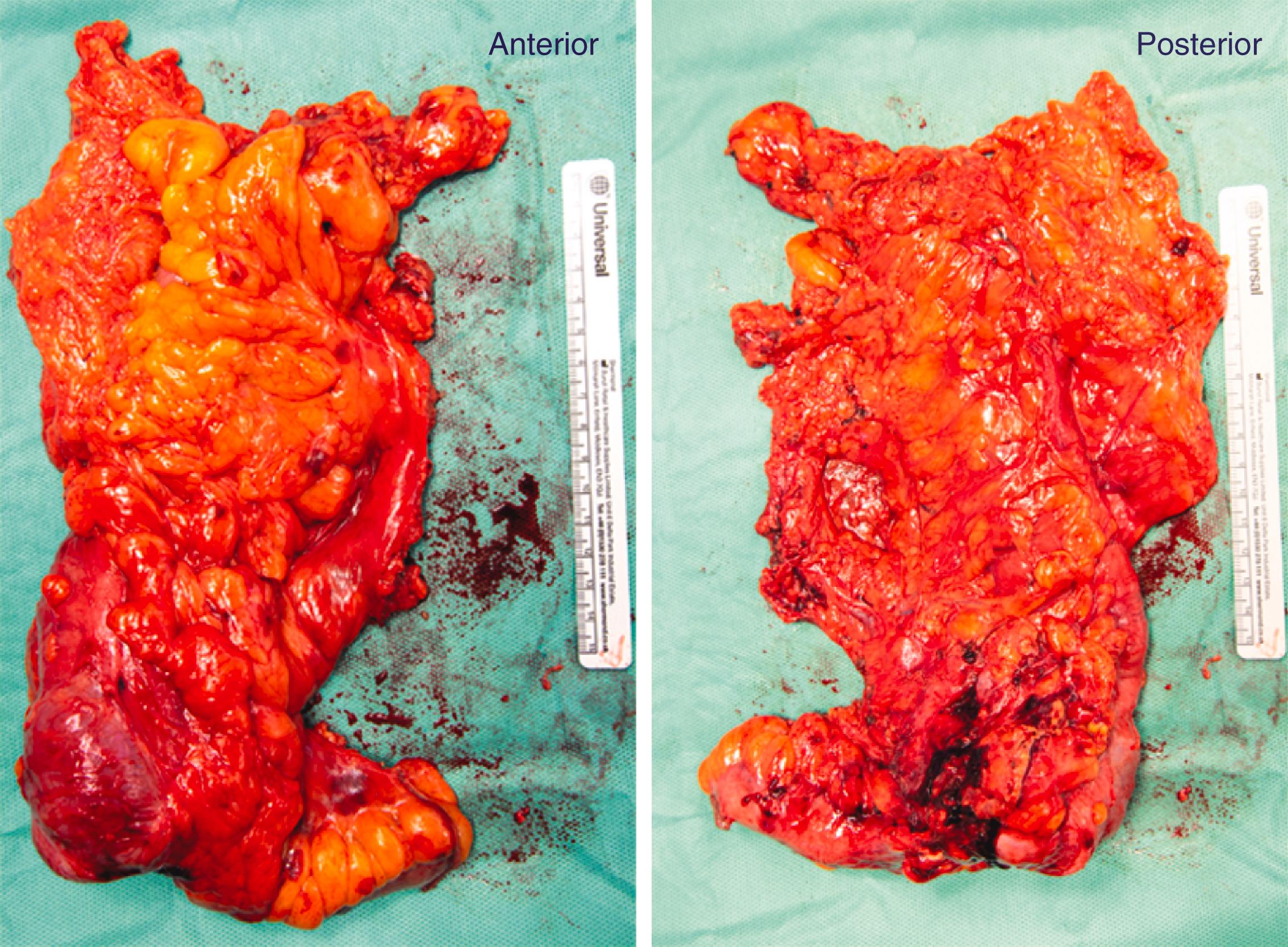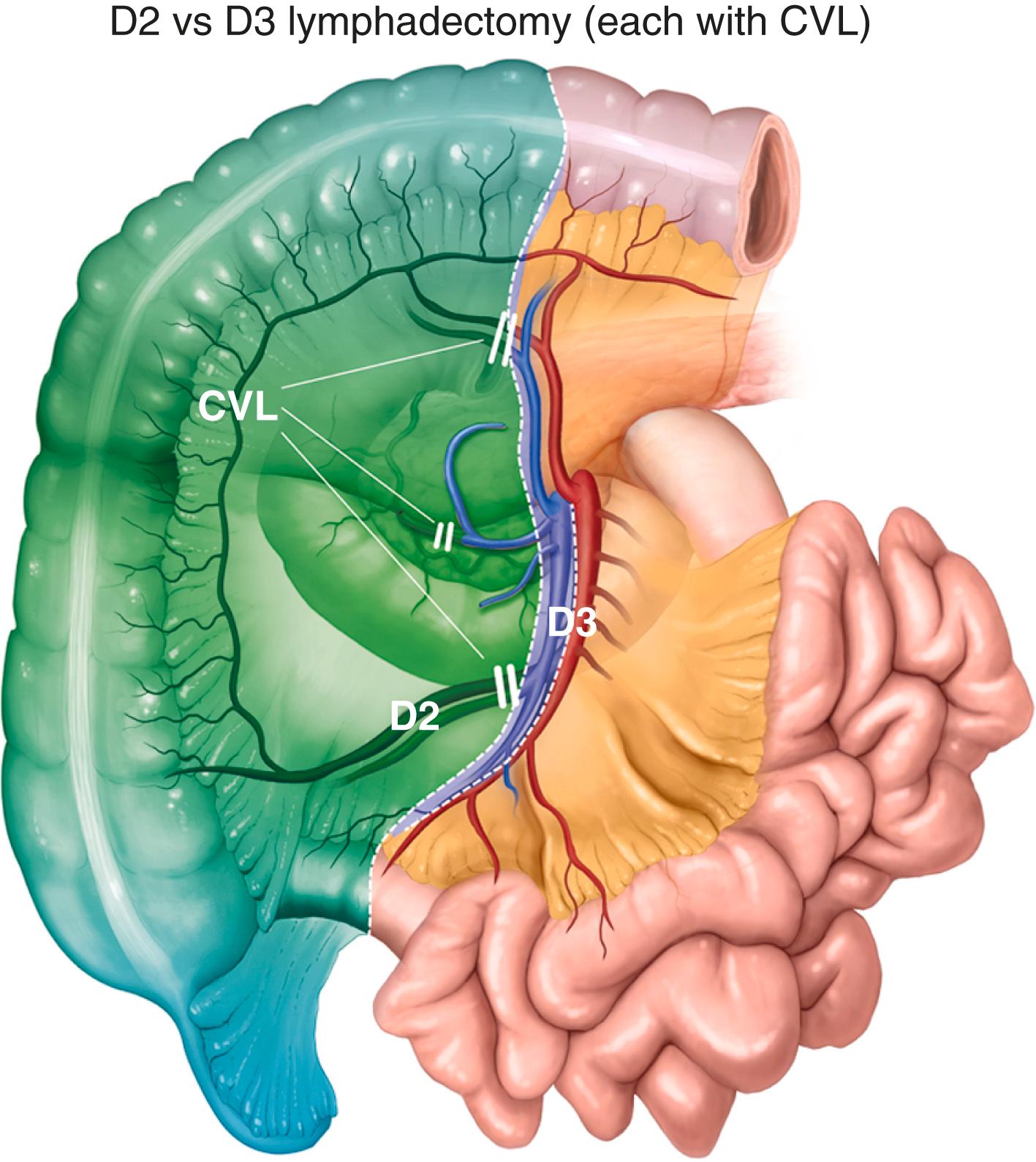Physical Address
304 North Cardinal St.
Dorchester Center, MA 02124
The authors and editors would like to thank Jordan Fletcher for developing and providing the illustrations for this chapter.
The principles of surgery for colon cancer have been unchallenged for decades, and include a sufficient longitudinal resection margin, excision of the draining lymphatic territory and avoidance of unnecessary manipulation of the tumour before transection of the vascular pedicle (‘no-touch technique’). Although these principles remain a mainstay of the surgical treatment for colon cancer, there is increasing controversy about the extent of resection, the definition of complete mesocolic excision (CME), and peri-operative treatment strategies, such as neoadjuvant chemotherapy and mechanical bowel preparation. Laparoscopic resection is nowadays regarded as the gold standard of care, but the value of novel concepts, such as robotic surgery and a complete minimally invasive approach, including intra-corporeal anastomosis and using natural orifices for access or specimen extraction is still debated. This chapter is focussed on current evidence and debates of the surgical principles of the treatment of colon cancer. Classification, tumour biology, genetics and oncological treatment options are discussed in previous chapters.
Colonic resection is classified within the National Institute for Health and Care Excellence (NICE) guidelines as major or complex surgery. Clear communication with the patient and their family regarding the diagnosis, risks and potential management options is required to facilitate shared decision making and formulation of an appropriate management plan for the individual. Pre-operative risk assessment is essential, not only to inform patients and surgeons regarding potential morbidity and mortality but also to address any reversible risk factors, which may be mitigated pre-operatively.
![]() There are a number of formalised risk assessment tools available including P-POSSUM, CR-POSSUM, SORT and NSQIP. These may be used alongside multi-disciplinary team discussions with the surgeon, anaesthetic team and specialist physicians, as appropriate, to facilitate shared decision making.
There are a number of formalised risk assessment tools available including P-POSSUM, CR-POSSUM, SORT and NSQIP. These may be used alongside multi-disciplinary team discussions with the surgeon, anaesthetic team and specialist physicians, as appropriate, to facilitate shared decision making.
Elderly patients should be screened for frailty using validated questionnaires. Formalised exercise tolerance tests (e.g., CEPEX) or stress echocardiography can be useful to further objectify increased risk. Medical optimisation of pre-existing cardiac or respiratory conditions should be considered promptly. Assessment of nutritional state, anaemia and lifestyle factors such as smoking must also be addressed. Patients with suspected malnutrition may benefit from high-calorie drinks pre-operatively. Intravenous iron or packed red blood cell transfusion, in severe cases, should be administered in cases of anaemia. , Smoking cessation must be encouraged, ideally at least 4 weeks before surgery, to avoid bronchial hypersecretion and normalise metabolic and immune function. Obese patients carry an increased risk of post-operative complications, but weight loss is often not feasible in the timeframe given in the cancer pathway. In selected cases of morbid obesity (BMI >40 kg/m 2 ), radical diet or the insertion of a gastric balloon can be considered. Each patient should be assigned a point of contact, such as a cancer nurse specialist, pre-operatively to answer any questions going forward and facilitate timely management.
![]() Enhanced recovery after surgery (ERAS) protocols have been shown to reduce complications and length of stay in patients undergoing elective colonic resection.
Enhanced recovery after surgery (ERAS) protocols have been shown to reduce complications and length of stay in patients undergoing elective colonic resection.
ERAS includes over 20 different elements of peri-operative care; minimally invasive surgery to reduce post-operative pain and the use of opioids, early mobilisation and early oral intake are some of the most relevant factors in a surgeon’s practice. A detailed care protocol and informing patients about expected progression on a daily basis are equally important.
The use of pre-operative mechanical bowel preparation and non-absorbable oral antibiotics, in addition to intravenous antibiotics 30–60 minutes before knife-to-skin, has been shown to significantly reduce the incidence of surgical site infection (SSI) in patients undergoing surgery for colorectal cancer. Large population-based, retrospective studies from the United States suggest that this regimen may be associated with lower anastomotic leak rates and ileus. The results of a randomised controlled trial including 417 patients from Finland however, did not show a reduction of SSI rates in patients undergoing colon resection.
Routine use of pre-operative mechanical bowel preparation and non-absorbable oral antibiotics before elective colorectal surgery is recommended by the World Health Organisation and American Society for Enhanced Recovery. An evidence review is currently being performed with the intention of updating the current NICE guidelines.
The incidence of post-operative venous thromboembolism (VTE) in patients undergoing colorectal surgery has been reported as 1.1–2.5%. This risk is higher for patients with colorectal cancer.
![]() Mechanical prophylaxis with graduated compression stockings and/or intermittent pneumatic compression and pharmacological prophylaxis with low-molecular-weight heparin is recommended. For cancer patients, it is recommended to extend the use of low-molecular-weight heparin 28 days post-operatively. ,
Mechanical prophylaxis with graduated compression stockings and/or intermittent pneumatic compression and pharmacological prophylaxis with low-molecular-weight heparin is recommended. For cancer patients, it is recommended to extend the use of low-molecular-weight heparin 28 days post-operatively. ,
Surgery remains the mainstay of treatment for localised colon cancer. The operation performed is defined by the location of the primary and the tumour is resected en bloc with the lymphatic drainage by ligation of the arterial supply to that section of colon. To achieve optimal oncologic outcomes, any adjacent organ involvement must also be resected en bloc.
Unlike in rectal cancer, where the optimal surgical technique, total mesorectal excision (TME), is well established and standardised, very few national guidelines describe the optimal surgical technique recommended for colonic cancer resections.
The ESMO guidelines recommend a minimum of 5 cm of bowel to be resected either side of the tumour with at least 12 draining lymph nodes. In practice, a greater longitudinal length of bowel resection is often mandated as a result of ligation of arterial supply.
Resection specimens can be assessed regarding the completeness and the quality of the resection margins.
![]() West et al. were the first to describe a grading system to assess the quality of colon cancer resection specimens based on the completeness of the mesocolic resection margin (mesocolic, intra-mesocolic and intramuscular) and demonstrated improved survival when surgery is performed in the ideal, mesocolic plane.
West et al. were the first to describe a grading system to assess the quality of colon cancer resection specimens based on the completeness of the mesocolic resection margin (mesocolic, intra-mesocolic and intramuscular) and demonstrated improved survival when surgery is performed in the ideal, mesocolic plane.
It was also shown that the correct plane of dissection is more often achieved in left-sided colon cancer resections compared with right-sided colon cancer resections. The length of the vascular pedicle is of limited use as it varies greatly between individual patients. A more recent grading system suggested by the German CME group also involves the completeness of the central extension of the mesocolic resection. Its clinical validation is yet to be shown ( Fig. 4.1 ).

The optimal extent of lymphadenectomy remains controversial. Colonic lymph node basins can be classified according to their proximity to the tumour-containing segment of bowel and supplying vasculature. Epicolic and paracolic lymph nodes (within 5 cm of the tumour containing bowel) may be termed group 1 or N1 lymph nodes and are resected in a D1 resection. Intermediate lymph nodes (5–10 cm from the tumour bearing colon segment) are termed group 2 or N2 lymph nodes . A D2 colonic resection refers to the resection of both N1 and N2 lymph nodes en bloc. Central lymph nodes at the root of the named vasculature are termed N3 lymph nodes and are resected with a D3 colonic resection. Japanese guidelines recommend a D3 resection is performed for all patients with pre-operative radiological suspicion of node positive disease or for those tumours radiologically staged as T4 without obvious nodal involvement on computed tomography (CT). Patients with tumours that do not meet these criteria are offered a D2 resection. No such guidance on extent of lymphadenectomy is provided in European guidelines. A potential pitfall for selective use of D2/D3 resection based on pre-operative radiological staging is the inaccuracy of CT scans in determining accurately the depth of tumour invasion and the presence or absence of positive lymph nodes. In a meta-analysis by Nerad et al., the sensitivity and specificity of CT to distinguish between T1/T2 versus T3/T4 disease was 90% and 69% while the accuracy of prediction of lymph node involvement was only 78% and 68%, respectively ( Fig. 4.2 ).

Become a Clinical Tree membership for Full access and enjoy Unlimited articles
If you are a member. Log in here